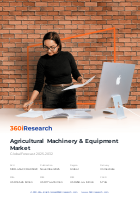
Agricultural Machinery & Equipment Market by Type (Harvesting Machinery, Haying & Forage Machinery, Irrigation Machinery), Automation Level (Automatic, Manual, Semi-Automatic), Power Source, Drive Type, Mobility, Application, End User, Ownership Type, Use Case, Sales Channel - Global Forecast 2025-2032
SKU
MRR-434CCDA0502C
Region
Global
Publication Date
December 2025
Delivery
Immediate
2024
USD 165.26 billion
2025
USD 174.41 billion
2032
USD 258.44 billion
CAGR
5.74%

Download a Free PDF
Get a sneak peek into the valuable insights and in-depth analysis featured in our comprehensive agricultural machinery & equipment market report. Download now to stay ahead in the industry! Need more tailored information? Ketan is here to help you find exactly what you need.



